What Is the Difference Between Baking Soda and Baking Powder?

Introduction
Baking soda and baking powder are essential ingredients in baking, but they’re not interchangeable. What is the difference between baking soda and baking powder? Understanding how they work can improve your baking results and help you avoid common mistakes. In this article, we’ll explain their differences, how they work, and when to use each.
1. The Basics of Baking Soda and Baking Powder
Baking Soda
- Chemical Name: Sodium bicarbonate.
- How It Works: Baking soda is a base that reacts with acidic ingredients (like lemon juice, buttermilk, or vinegar) to release carbon dioxide. This gas creates bubbles, causing dough or batter to rise.
- Key Point: Baking soda requires an acid to activate.
Baking Powder
- Components: Baking powder contains baking soda, an acid (usually cream of tartar), and a moisture-absorber (like cornstarch).
- How It Works: It’s a complete leavening agent that works without additional acids.
- Key Point: Baking powder often includes double-acting agents, which release gas twice—once when mixed and again when heated.
2. When to Use Baking Soda
Use baking soda when your recipe includes acidic ingredients such as:
- Buttermilk.
- Yogurt.
- Vinegar.
- Lemon juice.
- Honey or molasses.
Examples: Chocolate cake, banana bread, and certain cookie recipes.
3. When to Use Baking Powder
Use baking powder when your recipe does not include enough acidic ingredients to activate baking soda. It’s often used in:
- Cakes.
- Muffins.
- Pancakes.
Examples: Vanilla cakes and fluffy biscuits.
4. How to Substitute Baking Soda and Baking Powder
Substituting between baking soda and baking powder can be tricky:
- Baking Soda for Baking Powder: Use 1/4 teaspoon of baking soda with 1/2 teaspoon of vinegar or lemon juice for every teaspoon of baking powder.
- Baking Powder for Baking Soda: Use three times the amount of baking powder, but the flavor may change slightly.
5. Pro Tips for Perfect Results
- Measure Accurately: Too much baking soda can leave a metallic taste, while too much baking powder can make baked goods collapse.
- Combine Properly: Always mix thoroughly to distribute leavening agents evenly.
- Check Freshness: Test baking soda by adding vinegar—bubbles mean it’s active. For baking powder, use water instead.
Conclusion
Baking soda and baking powder serve similar purposes but work differently due to their chemical compositions. By understanding their roles and how to use them, you can achieve perfect results in your baked goods. For more baking tips and tricks, visit our Kuestion.com.




